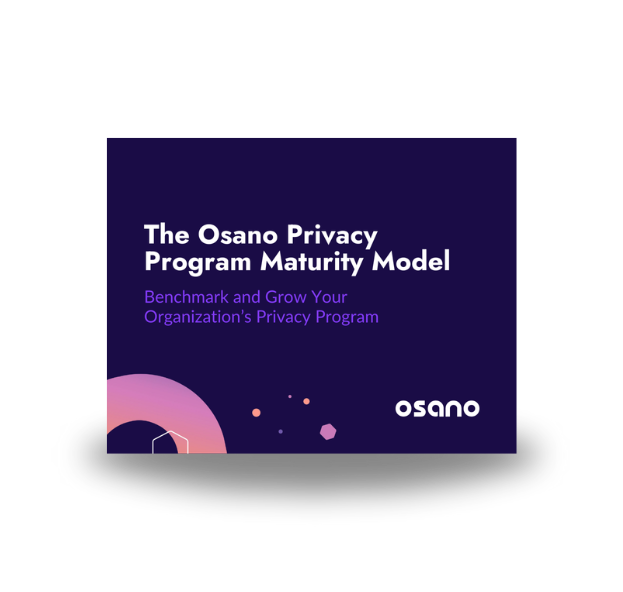One of data privacy’s greatest challenges is that it can all feel just so abstract.
What does it really mean for an individual’s data to be at “risk”? What activities are riskier than others? Where is the line between what is acceptable and what isn’t? And once you find that line, how do you enforce it?
That’s where privacy impact assessments (PIAs) come in. With PIAs, you can systematically identify and mitigate privacy risks. The best part is that PIAs are a straightforward, tangible task with clear outcomes. If you want to master the PIA process and ensure that you make the biggest impact possible, use this blog to learn about the top 7 PIA best practices. Not only will you stay compliant with data privacy laws, but you’ll also foster a culture of privacy that builds trust with custoremers and stakeholders alike.
1. Start with the “Why”
Nobody likes to take on additional work without knowing what the reason for it is. PIAs are something of a team sport; you’ll need others in your organization to understand why they should bother understanding and conducting a PIA.
Furthermore, understanding the intention behind PIA requirements will help you conduct better, more effective PIAs. If they’re just an annoying questionnaire you need to fill out, then it will be no surprise if members of your organization do the bare minimum.
Compliance is one major reason why PIAs matter. Laws like the California Privacy Rights Act (CPRA) and many other U.S. state privacy laws require PIAs to be conducted for businesses that handle sensitive personal information or conduct high-risk activities, like selling or sharing data externally and using automated decision-making technologies. Not conducting a PIA could constitute a violation for every consumer whose personal information you process. Given that most laws penalize individual violations in the thousands of dollars, that could add up to a six- or seven-figure fine pretty quickly.
The purpose behind these fines is to encourage you to do right by your organization’s customers and respect their data privacy rights. This, too, is another “why” for conducting PIAs—they, together with the other activities you conduct in a privacy program, demonstrate to consumers that you care about their privacy. Earning consumer trust is difficult, especially nowadays. PIAs are one way to show you care. Some organizations even publish the results of PIAs after redacting sensitive information.
PIAs also mitigate the risk of data breaches. Risky data transfers are ripe opportunities for both intentional and unintentional data breaches to occur, and these transfers will be part of your evaluation process when conducting a PIA. Furthermore, PIAs require you to assess whether you’re minimizing the amount and types of data necessary for a given project; you could process highly sensitive data that could be a serious liability where it to leak—only to find that it’s wholly unnecessary to have that data in the first place.
To summarize, PIAs:
- Keep you in compliance and avoid financial penalties.
- Earn consumer trust.
- Reduce the likelihood and risk of data breaches.
And they may have additional benefits unique to your organization or industry. If you keep these factors in mind when conducting a PIA and communicate them to other stakeholders, you’ll be more likely to have a positive impact.
2. Build a Strong Business Case
One of the major reasons to start with the “why” behind PIAs is to gain internal support. Once you know why you’re conducting these exercises, you’ll be better able to align them to business goals and gain the support of your C-suite.
This matters because C-suite buy-in can act as a powerful signal to the rest of the organization. If they’re onboard and give you the mandate to conduct a PIA, then you’ll have a much easier time securing the cooperation of data store owners, team leads, and other internal stakeholders. If they’re disinterested or even outright hostile to this sort of compliance activity, others will share that perspective.
Let the C-suite know that customers, partners, and employees care about data privacy—consider bringing this topic up with these stakeholders if it’s relevant and beneficial. Highlight organizations in the same industry or in similar stages that have been hit by privacy fines or caught up in investigative sweeps. Talk about the need for stronger data governance practices, pointing out areas of risk and unknown quantities. The exact message that will resonate the most will vary depending on your organization and the specific C-suite members you talk to, but invariably, there will be some element of data privacy and PIAs that speaks to a broader business value.
3. Extend Privacy Concerns Beyond Corporate Boundaries
Remember that you aren’t just responsible for the data handled within your own organization—if you send data downstream to vendors, you can be held responsible for that vendor’s data-handling practices as well.
Vendor assessments can be considered a type of PIA. After all, you’ll be analyzing the impact that transferring data to a third party will have on your users’ privacy. Conducting these assessments can help you pinpoint particularly risky transfers; unnecessary transfers; and transfers that require organizational and/or technical controls, such as contractual data processing addenda and/or regular audits.
Third-party data transfers introduce significant risk, and it’s hard to mitigate that risk since you don’t dictate your vendors’ operations. Organizations with a robust PIA process will be sure to pay closer attention when assessing vendors’ impact on privacy.
4. Educate and Nurture Privacy Champions
Seek out members of non-privacy teams who can be champions for data privacy in their respective functions. This could be a marketer who sees the potential of privacy for your brand, an engineer who balks at how much data is being collected by apps and websites, an IT/operations professional interested in minimizing shadow IT and unnecessary vendor relationships—privacy is a multifaceted domain, so there will be overlaps with other functions. These individuals can be your point of contact to either assist you with fulfilling PIAs or to convince their leaders to support your efforts.
Another way to promote privacy champions is to establish a privacy council. Consider meeting on a regular cadence to discuss your organization’s privacy posture, field questions around data privacy, and recognize support from your privacy champions. You can use this as an opportunity to discover new areas where PIAs or other privacy tasks are sorely needed and to educate your colleagues on how they can better support the PIA process.
5. Communicate Effectively
Remember how we started this list with finding out the “why” behind PIAs? That’s how you should start your PIA communications with your colleagues.
Make sure you communicate clearly what types of activities or conditions require an assessment and why. For example, if a product’s functionality depends on storing PI, it requires an assessment. If a marketing campaign purchases personal data for targeting and personalization, it requires an assessment. For assessments triggered on a regular basis, such as annual compliance PIAs, give people a heads-up and remind them that it’s on the calendar.
(Check out What Is a Privacy Impact Assessment (PIA) & How to Conduct One for more details on the basics of when to conduct a PIA).
Another way to think about communicating PIA requirements is as an exercise in effective project management. Make sure to set expectations around PIAs, such as creating SLAs for turnaround time. Give your colleagues a heads up on how much time they should expect to spend on a PIA. Make sure they know you’re a resource they can consult and be willing to guide colleagues who haven’t conducted a PIA before. As your PIA progresses, give colleagues an update and let them know about the outcomes.
6. Close the Loop and Make Continuous Improvements
After your colleagues take the time to complete your PIA, show your appreciation at the end of the process with a sincere thank you message. Tell them what the company and their business unit accomplished by completing the PIA and what it will enable the company to do better in the future. This is key and calls back to explaining the “why” behind PIAs. If your colleagues feel like they haven't accomplished anything and simply wasted their time, they aren’t likely to prioritize assessments in the future.
It’s also the perfect time to collect feedback from the team. It could be the case that team members didn’t understand aspects of the PIA process or felt surprised by the sudden task and deadline. Provide multiple ways to receive feedback, including an anonymous option.
Based on this feedback and your own observations, take note of what challenges you faced and how you might be able to overcome them. Many PIAs are conducted on a regular basis, so in between rounds of assessments is the perfect time to implement or ideate improvements.
Lastly, don’t forget to follow up on all of this with your leadership team. You’ve worked hard to secure their buy-in, and even if they weren’t directly involved in the process, they make the strategic considerations that make room for privacy assessments or deprioritize them.
7. Implement Technology for Streamlined Assessments
If you’ve conducted the PIA process manually, then the odds are that one of the improvements you’ve identified is to automate the process. Fortunately, privacy management tools for this very purpose exist. With the right technology, you can:
- Automate the assessment workflow by notifying assignees of upcoming assessment tasks, serving reminders, facilitating assessment creation, and more.
- Integrate with other systems your organization uses for data management, inventory, or classification. This could include your data map, for example, which would enable you to identify relevant data stores and their owners more quickly.
- Prioritize based on risk. Your privacy technology may be able to indicate that a certain vendor, system, or data flow handles sensitive information, has been potentially impacted by a data breach, or otherwise presents a higher level of risk. That way, you’ll know that a PIA may be needed and that it should take precedence over other competing tasks.
Mastering PIAs requires a holistic approach that combines the right mix of people, processes, and technology. By following these privacy impact assessment best practices, you can make sure that your PIAs are more effective and less disruptive from the start. But rather than go through the trial-and-error process of seeing what works and what doesn’t with your PIA process, consider adopting a technology solution from the start.
Osano Assessments centralizes and streamlines all of your privacy assessments, including not only PIAs but also data protection impact assessments (DPIAs), records of processing activities (RoPAs), vendor assessments, and more. What’s more, Osano Assessments is fully integrated with the rest of the Osano Platform, accelerating the assessment process through data mapping and discovery, vendor management, consent management, and other critical data privacy compliance tasks.
Schedule a demo today to see how Osano can help you master PIAs.
Privacy Program Maturity Model
Looking to level up your privacy program as a whole, including your assessment process? Our maturity model gives you the tools to score and evaluate your privacy program so you can become operationally efficient.
Download Your Copy
Matt Davis, CIPM (IAPP)
Matt Davis, CIPM (IAPP)
Matt Davis is a writer at Osano, where he researches and writes about the latest in technology, legislation, and business to spread awareness about the most pressing issues in privacy today. When he’s not writing about data privacy, Matt spends his time exploring Vermont with his dog, Harper; playing piano; and writing short fiction.
.webp?width=1220&height=1090&name=Osano-guarantee-seal%20(1).webp)



